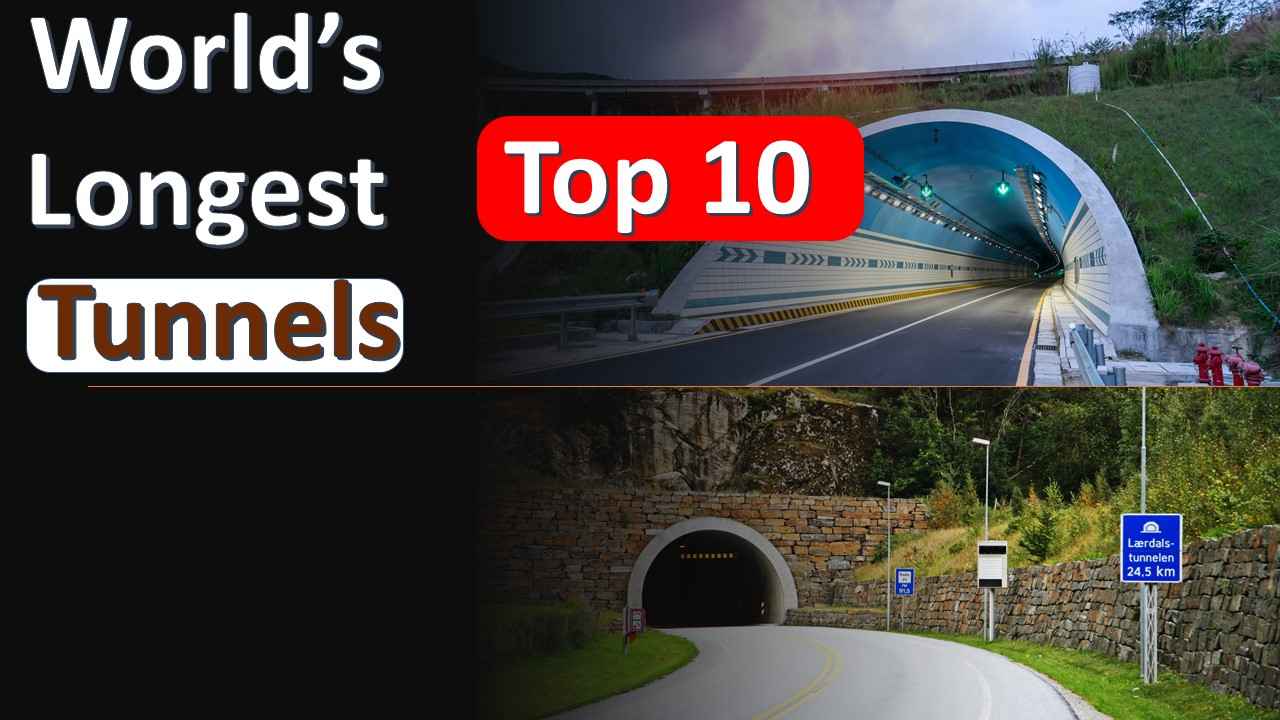Top 10 Longest Tunnels in the World
- By
- Pooja |
- April 08, 2023 |
- Civil Engineering, Tunnel Engineering,

Table of Contents
Gotthard Base Tunnel, Switzerland (57.1 km)
Seikan Tunnel, Japan (53.85 km)
Channel Tunnel, United Kingdom/France (50.45 km)
Lötschberg Base Tunnel, Switzerland (34.57 km)
Laerdal Tunnel, Norway (24.51 km)
Hsuehshan Tunnel, Taiwan (12.94 km)
Zhongnanshan Tunnel, China (18.02 km)
Guoliang Tunnel, China (1.2 km)
St. Gotthard Tunnel, Switzerland (15 km)
Eiksund Tunnel, Norway (7.8 km)
Tunnels have revolutionized transportation and infrastructure by providing efficient and faster ways to travel. They make it possible to connect two places that are separated by natural obstacles such as mountains, seas, and rivers. This blog post will explore the top 10 longest tunnels on the Earth, based on their length, significance, and impact on transportation infrastructure.
Gotthard Base Tunnel, Switzerland (57.1 km)
The Gotthard Base Tunnel is the longest tunnel on the earth and a remarkable feat of engineering. It is a railway tunnel located in Switzerland, running under the Gotthard mountain range. The tunnel took 17 years to build and cost a staggering 11 billion Swiss francs. The tunnel is a key link between southern and northern Europe, and it reduced travel time between Zurich and Milan by one hour.
The Gotthard Base Tunnel uses state-of-the-art technology, including a central ventilation system that filters and circulates the air. It is also equipped with an innovative fire detection and suppression system, which can detect and extinguish fires within seconds.
Seikan Tunnel, Japan (53.85 km)
The Seikan Tunnel is the longest undersea tunnel, placed in Japan. It connects the islands of Hokkaido and Honshu and took 25 years to build. The tunnel is a critical transportation link between the two islands and has revolutionized transportation in the region.
The Seikan Tunnel uses a variety of cutting-edge technologies, including air pressure systems, which allow trains to run safely through the tunnel. The tunnel also features an innovative ventilation system, which regulates the temperature and humidity inside the tunnel.
Channel Tunnel, United Kingdom/France (50.45 km)
The Channel Tunnel, also known as the Eurotunnel, is a vital transportation link between the United Kingdom and France. It is the world's longest undersea rail tunnel, and it took six years to build. The tunnel opened in 1994 and revolutionized travel between the two countries, reducing travel time between London and Paris.
The Channel Tunnel uses a variety of innovative technologies, including air conditioning systems, which regulate the temperature and humidity inside the tunnel. It also has a unique safety system that allows trains to continue moving in case of a fire, and it features state-of-the-art signalling and communications systems.
Read More:
Lötschberg Base Tunnel, Switzerland (34.57 km)
The Lötschberg Base Tunnel is a railway tunnel located in Switzerland, running under the Bernese Alps. It opened in 2007 and is a vital link in the Swiss railway network, reducing travel time between Bern and Milan.
The tunnel uses advanced ventilation and air conditioning systems, which ensure a comfortable temperature and humidity level for passengers. It also has an innovative safety system that can detect potential issues, such as fires or train malfunctions, and alert the appropriate authorities.
Laerdal Tunnel, Norway (24.51 km)
The Laerdal Tunnel is a road tunnel located in Norway, running through mountains. It is the longest road tunnel and it opened in the year 2000. The tunnel is a vital link in the Norwegian road network and reduces travel time between Bergen and Oslo.
The Laerdal Tunnel is equipped with advanced lighting systems, which make it possible to drive through the tunnel safely. It also features air conditioning and ventilation systems that regulate the temperature and humidity levels inside the tunnel.
Hsuehshan Tunnel, Taiwan (12.94 km)
The Hsuehshan Tunnel is a road tunnel located in Taiwan, running under the Hsuehshan mountain range. It opened in 2006 and is a key link in the Taiwan road network, reducing travel time between Taipei and Yilan.
Tunnels have played a crucial role in transportation infrastructure for centuries. They allow people and goods to travel through mountains, under rivers and across oceans, making it easier and quicker to reach destinations. In this blog post, we will explore the top 10 longest tunnels in the world, based on their length and impact on transportation infrastructure.
Zhongnanshan Tunnel, China (18.02 km)
The Zhongnanshan Tunnel is a road tunnel located in China. It runs through the Zhongnan mountain range and opened in 2007. The tunnel is a key link in the Chinese road network and reduced travel time between Xi'an and Ankang.
The construction of the Zhongnanshan Tunnel began in 1999 and was completed in 2007. The tunnel is a part of the Zhengzhou-Xi'an Highway, which connects the cities of Zhengzhou and Xi'an. It is also a part of the larger network of highways in China, known as the National Trunk Highway System.
The Zhongnanshan Tunnel is one of the longest highway tunnels in the world and is known for its engineering complexity. It was built using state-of-the-art technology and required the construction of ventilation systems, lighting systems, and safety systems to ensure the safe and efficient flow of traffic through the tunnel.
Guoliang Tunnel, China (1.2 km)
The Guoliang Tunnel is a road tunnel located in China's Henan Province that stretches for a length of 1.2 kilometres. It is carved into the side of the Taihang Mountains and is famous for its unique location and construction.
The tunnel was built by local villagers in the late 1970s and early 1980s. Before the tunnel was built, the villagers had to climb up and down the steep mountain paths to reach the outside world. The idea of constructing a tunnel to connect their village with the outside world was conceived by Shen Mingxin, a villager who had been injured while climbing the mountain.
The construction of the tunnel was a tough task, as the villagers had to use hand tools to carve the tunnel through the solid rock. They also had to create their own ventilation system to ensure the safety of those who travelled through the tunnel.
Today, the Guoliang Tunnel is a popular tourist attraction and is often referred to as one of the utmost dangerous roads. Despite its narrow width and lack of safety features, thousands of visitors flock to the tunnel each year to experience its unique beauty and marvel at the remarkable achievement of its construction by local villagers.
St. Gotthard Tunnel, Switzerland (15 km)
The St. Gotthard Tunnel is a road tunnel located in Switzerland. It runs under the Gotthard mountain range and opened in 1980. The tunnel is a key link in the Swiss road network and reduced travel time between Zurich and Milan.
The tunnel is a part of the A2 highway, which connects the cities of Basel and Chiasso. It is also a part of the larger network of highways in Europe, known as the European route E35.
The St. Gotthard Tunnel is one of the longest highway tunnels on the earth and is known for its engineering complexity.
The St. Gotthard Tunnel has significantly reduced the travel time between the cantons of Uri and Ticino and has played a critical role in improving the transportation infrastructure in Switzerland. It is also an important transit route for international freight traffic and has helped to facilitate trade between Northern and Southern Europe.
Eiksund Tunnel, Norway (7.8 km)
The Eiksund Tunnel is a road tunnel located in Norway. It runs under the Eiksund strait and opened in 2008. The tunnel is a key link in the Norwegian road network and reduced travel time between Molde and Ålesund.
It is a part of the E39 coastal highway, which runs along the western coast of Norway, connecting cities and towns in the region. The Eiksund Tunnel is one of the deepest subsea tunnels in the world, with a maximum depth of 287 meters below sea level.
These tunnels have played a crucial role in improving transportation infrastructure, reducing travel time and increasing connectivity. As technology continues to advance, we can expect to see even longer tunnels in the coming future.
I hope the blog provides you an interesting information of the longest tunnels in the world.
Please feel free to like, share and comment.
Admin, gcelab.com
Please see our Pillar Post to know why we founded gcelab.com.
Read More:

Pooja
Founder at gcelab.com, Pooja is an Entrepreneur unlocking human potential. Working in the Principles of Lean Start-up, Pooja believes in Transparency and User Happiness the most. Pooja’s background in teaching gives her a sophisticated grasp on even the most tedious aspect of course building. She is passionate about people who believe that good is not enough.
Previous Post


